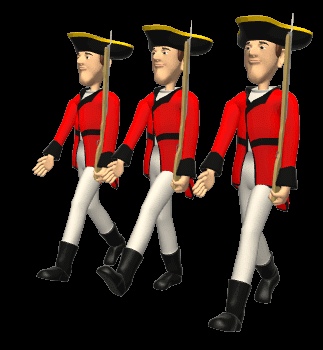This post is about the life of the soldiers, especial the ones during the colonial period. As you know the life of a soldier is never easy and has never been throughout history. During the colonial period, two armies existed; The British Army and the Colonial or American Army. Both armies had similarities and differences. The American Army wasn’t a real army it was more like a militia. When the colonies needed to defend from the British, the militia was ready to attack. Of course the training in the British army was rigorous and better but the men in the British army didn’t have what the men in the American militia had, desire to defend their homeland which later became the United States of America. If these men in the colonial militia, together with all the other men in the House of Burgesses, the Sons of Liberty and the patriots in general did not stood up agains the British tyranny, we wouldn’t have the great nation we have today, the United States of America.
The soldiers in the British Army were farmers, low laborers, and thieves who were avoiding to go to prison. Citizens from England enlisted in the army because during times of war, the government offered ten times the money a man could earn at a normal job. Citizens in England earned very little in their jobs, so this opportunity was really hard for a men to pass up. The government provided food and cloth to the British soldiers and even shelter because of the Quartering Act, so the money they earned was completely for their families. Sometimes the British soldiers were allowed to take their family wherever they were sent. The British soldiers received a hard training before they were able to attend a mission or a war. They were also very ordered even to attack! During an attack, one of the rows would kneel down with their weapons ready and the other row would stand behind with their weapons over the heads of the kneeling army. The uniforms were very elegant. They consisted of a red coat, a ruffled shirt, tight leggings, high black boots and a tall black hat. The weapon the British army used was called the “Brown Bess”. The British Army was the most powerful army of the time because of their bravery and hard training.
In the other hand we have the colonial army or Militia. It was composed of common laborers, workers and property owners. Before the Revolutionary War against England, England gave money to the militia to buy supplies. As you can imagine this support was cut off during the war against them. After the support from England was cut, wealthy men like John Hancock and countries who wanted to see British defeated, gave the supplies needed to the militia. The money paid was not that much and it was only paid after the soldiers completed their enlistment time. Most of the weapons the men in the militia used were weapons they personally owned such as hunting muskets. Not everybody in the militia used uniforms as they weren’t enough and officers usually paid for their uniforms. They did not have an special training as the one the British Army had. The fighting methods they used were the ones they learned from the British Army and the Native Americans. These last ones were most effective. These methods consisted in hiding behind rocks and trees to difficult the visibility of the militia to the British soldiers. The British couldn’t shoot at will, while the colonists would shoot or fire at will, then they will run and hide. George Washington discovered this was an effective way of fighting against the British and together with the advantage that they were fighting in their homeland, they used these to win the battles.
 British Soldiers.
British Soldiers.

